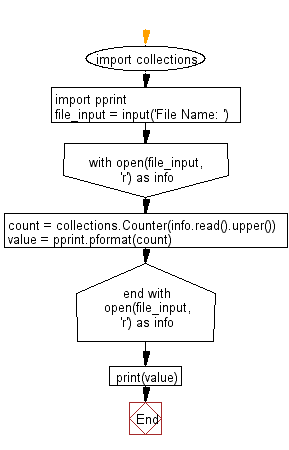Python: Count the number of each character of a given text of a text file
Character Frequency in File
Write a Python program to count the number of each character in a text file.
Inputs:
abc.txt -
German Unity Day
From Wikipedia, the free encyclopedia
The Day of German Unity (German: Tag der DeutschenEinheit) is the national day of Germany, celebrated on 3 October as a public holiday. It commemorates the anniversary of German reunification in 1990, when the goal of a united Germany that originated in the middle of the 19th century, was fulfilled again. Therefore, the name addresses neither the re-union nor the union, but the unity of Germany. The Day of German Unity on 3 October has been the German national holiday since 1990, when the reunification was formally completed.
Sample Solution:
Python Code:
# Import necessary modules.
import collections # Import the 'collections' module for Counter.
import pprint # Import 'pprint' for pretty printing.
# Get the file name as input from the user.
file_input = input('File Name: ')
# Open the file in read mode using a 'with' statement to ensure proper handling of resources.
with open(file_input, 'r') as info:
# Read the contents of the file and count the occurrences of each uppercase character.
count = collections.Counter(info.read().upper())
# Use 'pprint' to format the count output for better readability.
value = pprint.pformat(count)
# Print the formatted count of characters in the file.
print(value)
Sample Output:
File Name: abc.txt
Counter({' ': 93,
'E': 64,
'N': 45,
'A': 42,
'T': 40,
'I': 36,
'O': 31,
'R': 29,
'H': 25,
'D': 19,
'M': 17,
'Y': 17,
'L': 15,
'F': 15,
'U': 14,
'C': 13,
'G': 13,
'S': 12,
',': 7,
'B': 6,
'W': 5,
'9': 5,
'.': 4,
'P': 4,
'1': 3,
'\n': 2,
'0': 2,
'3': 2,
':': 1,
'-': 1,
'K': 1,
'(': 1,
')': 1,
'V': 1})
Explanation:
The above code takes a filename as input from the user. It reads the file content, converts it to uppercase, and then counts the occurrences of each uppercase character. The results are pretty-printed using the 'pprint' module in Python's standard library.
Flowchart:

For more Practice: Solve these Related Problems:
- Write a Python program to count the frequency of each alphabet character in a file, ignoring case.
- Write a Python program to count character frequencies in a file while excluding all whitespace characters.
- Write a Python program to identify and display the top 5 most frequent characters found in a text file.
- Write a Python program to create a histogram showing the frequency of each character from a given file.
Go to:
Previous: Write a Python program to print a long text, convert the string to a list and print all the words and their frequencies.
Next: Write a Python program to get the top stories from Google news.
Python Code Editor :
Have another way to solve this solution? Contribute your code (and comments) through Disqus.
What is the difficulty level of this exercise?
Test your Programming skills with w3resource's quiz.
